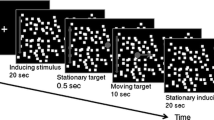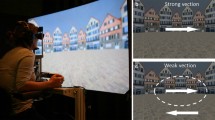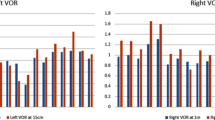Abstract
When the visual background is moving while subject fixate a visual target, optokinetic eye movements (OKN) are suppressed and the after response, called optokinetic after nystagmus (OKAN), occurring at the stimuli offset is often inverted as compared to the situation when the OKN movements are allowed. In this study, we investigated whether this reversal of OKAN results from a perceptual or extra-retinal feedback in relation with the pursuit system and/or the vestibular indirect system. Optokinesis performance was studied in normal subjects in four experiments always using the same background motion (1) to characterize the OKN and OKAN performance elicited by the whole visual field motion while fixating or not a central visual target, (2) to investigate the 3D characteristics of the OKAN reversal by using different orientations of the visual stimulation, (3) to correlate the occurrence of an inverted OKAN with functional asymmetry of the visuo-vestibular system, by studying the effects of ocular fixation deviations and finally (4) to examine the effects of the depth plane of gaze fixation on the OKAN characteristics. In Experiments 1 and 2, we observed that the visual fixation during full-field motion induced either a dumping effect or an inversion of the OKAN response that could occur in the different planes of eye movements. The time constant was significantly increased in the inverted after-responses as compared to the not inverted ones. In Experiment 3, we found that the occurrence of an OKAN reversal after eye movement inhibition was significantly related to the presence of right/left asymmetrical OKAN responses. Moreover, the OKAN time constant was strikingly dependent on the eye fixation position during the visual stimulation and this time constant/eye position relation diverged between OKAN responses with and without inversion. Finally, Experiment 4 showed that the OKAN inversion tended to disappear when the visual target to fixate was in the near space as compared to the far space included in the background. These results argue in favor of an extraretinal influence in relation to the dynamics of the vestibulo-motor system, rather than for a perceptual influence on the inverted OKAN mechanisms. More precisely, we postulate that the reversal of OKAN could be linked to an inhibition issued from pursuit signals combined with an asymmetrical activity in the VSM vestibular complex.




Similar content being viewed by others
References
Bense S, Janusch B, Schlindwein P, Bauermann T, Vucurevic G, Brandt T, Stoeter P, Dieterich M (2006) Direction-dependent visual cortex activation during horizontal optokinetic stimulation (fMRI study). Hum Brain Mapp 27:296–305
Brandt T, Dichgans J, Büchle W (1974) Motion habituation: inverted self-motion perception and optokinetic after-nystagmus. Exp Brain Res 21:337–352
Cannon SC, Robinson DA (1987) Loss of the neural integrator of the oculomotor system from brain stem lesions in monkey. J Neurophysiol 57:1383–1409
Cheron G, Gillis P, Godaux E (1986) Lesions in the cat prepositus complex: effects on the optokinetic system. J Physiol 372:95–111
Cohen B, Matsuo V, Raphan T (1977) Quantitative analysis of the velocity characteristics of optokinetic nystagmus and optokinetic after-nystagmus. J Physiol 270:321–344
Denise P, Darlot C, Ignatiew-Charles P, Toupet M (1996) Unilateral peripheral semicircular lesion and off-vertical axis rotation. Acta Otolaryngol 116:361–367
Dieterich M, Bucher SF, Seelos KC, Brandt T (1998) Horizontal or vertical optokinetic stimulation activates visual motion-sensitive, ocular motor and vestibular cortex areas with right hemispheric dominance. An fMRI study. Brain 121:1479–1495
Heckmann T, Post RB, Deering L (1991) Induced motion of a fixated target: influence of voluntary eye deviation. Percept Psychophys 50:230–236
Howard IP, Gonzalez E (1987) Human optokinetic nystagmus in response to moving binocularly disparate stimuli. Vision Res 27:1807–1816
Howard IP, Simpson WA (1989) Human optokinetic nystagmus is linked to stereoscopic system. Exp Brain Res 78:309–314
Ilg UJ (1997) Slow eye movements. Prog Neurobiol 53:293–329
Katz E, Vianney de Jong JM, Buettner-Ennever J, Cohen B (1991) Effects of midline medullary lesions on velocity storage and the vestibulo-ocular reflex. Exp Brain Res 87:505–520
Kitazaki M, Sato T (2003) Attentional modulation of self-motion perception. Perception 32:475–484
Kodaka Y, Miura K, Suehiro K, Takemura A, Kawano K (2004) Ocular tracking of moving targets: effects of perturbing the background. J Neurophysiol 91:2474–2483
Kudo K, Yoshida M, Makishima K (2002) Reverse optokinetic after-nystagmus generated by gaze fixation during optokinetic stimulation. Acta Otolaryngol 122:37–42
Lafortune S, Ireland DJ, Jell RM, DuVal L (1986) Human optokinetic afternystagmus. Stimulus velocity dependence of the two-component decay model and involvement of pursuit. Acta Otolaryngol 101:183–192
Lindner A, Ilg UJ (2006) Suppression of optokinesis during smooth pursuit eye movements revisited: the role of extra-retinal information. Vision Res 46:761–767
Nakamura S, Shimojo S (2003) Sustained deviation of gaze direction can affect “inverted vection” induced by the foreground motion. Vision Res 43:745–749
Ohmi M, Howard IP (1988) Effect of stationary objects on illusory forward self-motion induced by a looming display. Perception 17(1):5–11
Pola J, Wyatt HY, Lustgarten M (1995) Visual fixation of a target and suppression of optokinetic nystagmus: effects of varying target feedback. Vision Res 35:1079–1087
Schraa-Tam CK, van der Lugt A, Frens MA, Smits M, van Broekhoven PC, van der Geest JN (2008) An fMRI study on smooth pursuit and fixation suppression of the optokinetic reflex using similar visual stimulation. Exp Brain Res 185:535–544
Suehiro K, Miura K, Kodaka Y, Inoue Y, Takemura A, Kawano K (1999) Effects of smooth pursuit eye movements on ocular responses to sudden background motion in humans. Neurosci Res 35:329–338
Telford L, Spratley J, Frost BJ (1992) Linear vection in the central visual field facilitated by kinetic depth cues. Perception 21:337–349
Ventre-Dominey J, Luyat M, Denise P, Darlot C (2008) Motion sickness induced by otolith stimulation is correlated with otolith-induced eye movements. Neuroscience 155:771–779
Waespe W, Schwartz U (1986) Characteristics of eye velocity storage during periods of suppression and reversal of eye velocity in monkeys. Exp Brain Res 65:49–58
Wyatt HJ, Pola J (1984) A mechanism for suppression of optokinesis. Vis Res 12:1931–1945
Acknowledgments
The authors thank Dr. Peter Ford Dominey for his help with the English text. We are grateful to the participants of this study. This research has been funded by a grant from the Ministère de la Recherche “ACI-Programme Cognitique” (cog no. 95). The experiments were performed at the CNRS-UMR5015, Bron, France.
Author information
Authors and Affiliations
Corresponding author
Electronic supplementary material
Below is the link to the electronic supplementary material.
Rights and permissions
About this article
Cite this article
Ventre-Dominey, J., Luyat, M. Asymmetry of visuo-vestibular mechanisms contributes to reversal of optokinetic after-nystagmus. Exp Brain Res 193, 55–67 (2009). https://doi.org/10.1007/s00221-008-1595-2
Received:
Accepted:
Published:
Issue Date:
DOI: https://doi.org/10.1007/s00221-008-1595-2




